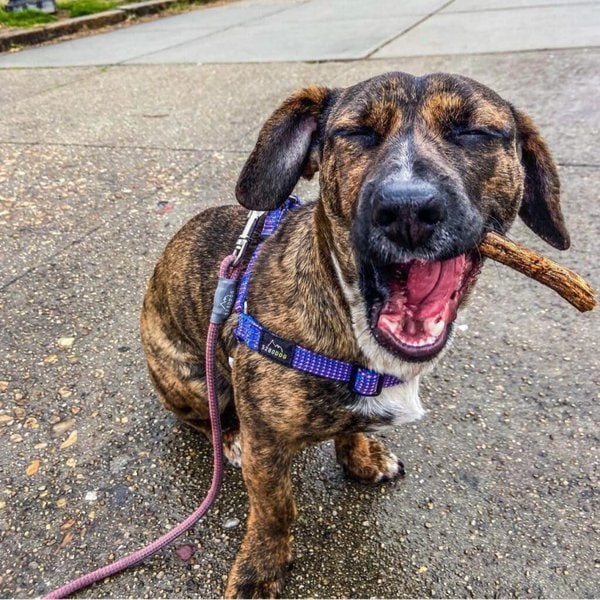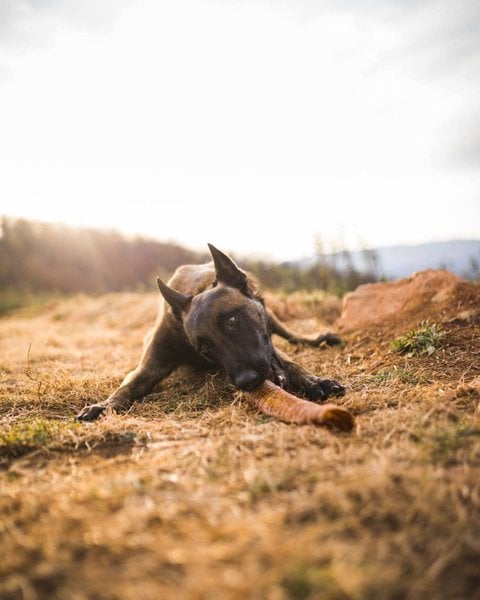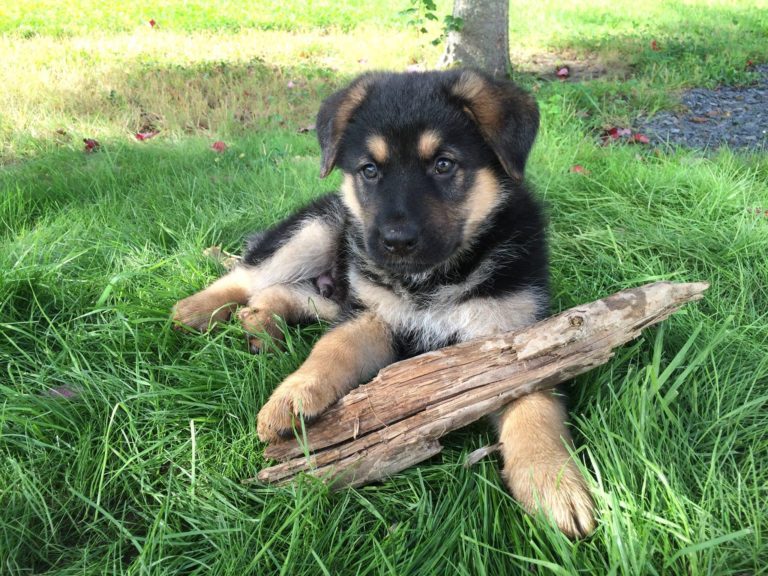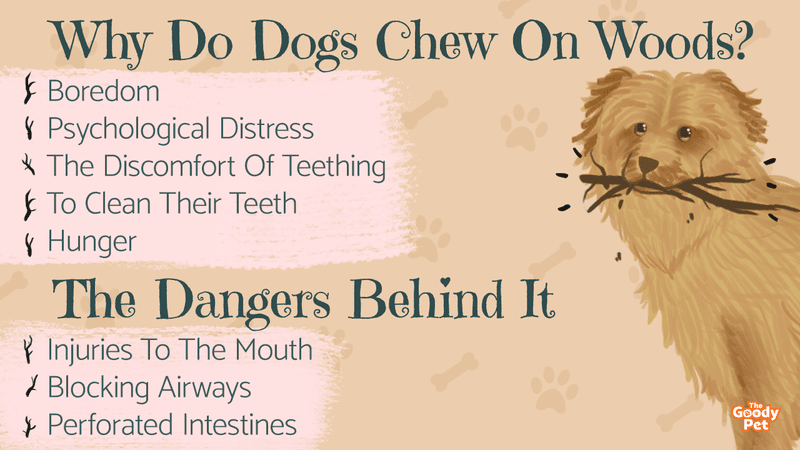Has your dog ever started chewing on an old piece of wood or even a new piece of lumber you have lying around the house? It’s a fairly common behavior for dogs, but do you know why they do it?
There are a few reasons why dogs might chew on wood. It could be that they’re trying to get attention, they’re bored, or they’re teething and looking for something to gnaw on. Chewing is a natural behavior for dogs.
One of the best things you can do is provide your dog with plenty of chew toys. This will give them something to chew on that is safe and won’t damage your belongings. You can also train your dog with positive reinforcement so that they know that chewing on their toys is a good thing.
Why Do Dogs Chew On Wood?
Dogs chew on wood mainly out of habit. In these cases, the act of chewing on something hard gives the usually bored or distressed dog something to focus on and let out any of their frustrations on.
Here is a bit more on why dogs chew on wood and how to identify the specific trigger for the habit.
Boredom
Boredom is a common reason why dogs chew on wood, especially when they are puppies. This is typically accompanied by other destructive or attention-seeking behavior, from barking and whining to scratching furniture and obsessively digging.
Psychological Distress
Dogs may also chew on wood as a way to deal with psychological stress. This could be anything from separation anxiety to phobias and frustration from inadequate engagement.
As with boredom, a psychologically distressed dog may also display destructive behavior. What stands out the most, in this case, is a major, sustained change in the dog’s personality. They may either become aggressive and mean or unusually withdrawn.
The Discomfort Of Teething
Teething can be a very uncomfortable experience for puppies. Chewing on hard surfaces like wood helps offer some relief which is why you may find your pup obsessively gnawing away at a branch they find outside.
To Clean Their Teeth
Dogs may not have the same understanding of dental hygiene that humans do, but they know enough to occasionally make an effort to keep their teeth clean.
One way this is done is by chewing on hard surfaces like wood. This helps by mechanically removing plaque and stuck bits of food from the dog’s teeth.
Hunger
Finally, your dog might be chewing on odd objects, including wood, to let you know that they are hungry. In some cases, it could be that the dog is lacking some crucial minerals and is instinctively chewing on the wood in an attempt to get what its body needs.
What Are Dogs Looking For When Chewing On Wood?

Some dogs chew on wood as a way to get minerals that their bodies lack. This condition is known as pica and manifests as the dog chewing on or consuming non-nutritive substances.
Pica is triggered by nutritional deficiencies in their diet for minerals. It could also be a result of electrolyte imbalances secondary to losses like excessive vomiting or diarrhea.
Some clues that could help you identify pica as the reason why your dog is chewing on wood include:
- Poor coat health
- Loss of weight or general failure to thrive
- Weakness
- Tremors
- Changes in bowel habits to either constipation or diarrhea
- Coprophagia, or consuming feces
If you notice these signs and symptoms in a dog that is chewing on wood excessively, you may want to book a visit with your vet to have them evaluated. You should also look into changing your dog’s diet to a more balanced brand of dog food.
Should I Let My Dog Chew On Wood?
You should not let your dog chew on wood as they risk suffering from several injuries as well as other health consequences. Here is all that could go wrong if you let your dog keep chewing on wood.
Injuries To The Mouth
These include cuts and puncture wounds to their tongue, gums, and lips. It could result in serious oral infections, especially where the dog’s dental hygiene isn’t consistently attended to.
In some cases, splinters could get stuck in existing dental cavities. This will cause the dog a lot of pain and may even result in the dog intentionally starving to avoid the discomfort of chewing.
Blocking Or Perforating The Digestive Tract Or Airway
For dogs that actually swallow pieces of the wood, either intentionally or by accident, could end up with injuries to their digestive tracts. The splinters could get lodged in the lining of the tract and cause healing by constriction.
Depending on where the constriction is, the dog will suffer from lifelong issues, including difficulties swallowing or persistent constipation.
The same could also happen to the airways if the splinters are accidentally aspirated by the pooch.

Perforated Intestines
In very serious cases, the splinters that the dog swallows after chewing on wood could cause perforation of the esophagus, stomach, or intestines. In most cases, this ends up being fatal for the dog.
Poisoning From Agrochemical Remnants
Finally, chewing on wood is harmful to dogs as it could expose them to chemical residues from things like fertilizers or pesticides sprayed onto plants.
The effects range from something survivable like vomiting and some gut irritation to life-threatening consequences like kidney failure.
How Do I Get My Dog To Stop Chewing On Wood?
The best way to stop your dog from chewing on wood is by limiting their access to the wood while offering safer alternatives for them to chew on. To help you out, here are some strategies that will come in very handy if you are trying to get your dog to stop chewing on wood.
Limit Access To Wood And Wooden Products
Limiting access to wood may include keeping your dog indoors or only letting them out where you know they won’t come across wooden objects to chew on.
If you have items like wooden furniture stands in your home, it would be best to restrict your dog’s access to those spaces for a while.
With time, your dog should lose interest in the wood and find something else to gnaw on.
Positive And Negative Reinforcement Techniques
Dogs are very smart and can thus be trained to avoid chewing on wood by using a balance of rewards and non-violent punishments.
Reward your dog with treats and praise every time they drop the piece of wood on command. On the other hand, use firm commands like “drop it” or “stop” whenever they start chewing on wood to let them know that it is not an encouraging habit.

Apply Dog-Repellent Products On Furniture Or Wood Trims
This is a fantastic tactic to help you stop your dog from chewing on the wood on your furniture or home detailing. There are many kinds of dog repellants from dog sprays and pastes with flavors that dogs hate to things like plastic spikes or alarms that warn the dog to stop.
Invest In Chew Toys
You can also stop your dog from chewing on wood by giving it something better to focus its energy on. Invest in a wide variety of chew toys in terms of shapes, sizes, and textures, and let your dog figure out which one they like best.
It could help if you got a chew toy that looks similar to a piece of wood as a transition away from the unwanted habit.
Book A Visit With A Vet
If all the strategies highlighted above don’t work or if you suspect pica as the reason why your dog won’t stop chewing wood, it may be time to get a veterinarian involved.
It helps if the vet also has some experience in pet psychology, as a lot of times the underlying reason why your dog won’t stop chewing on wood is psychological distress.





